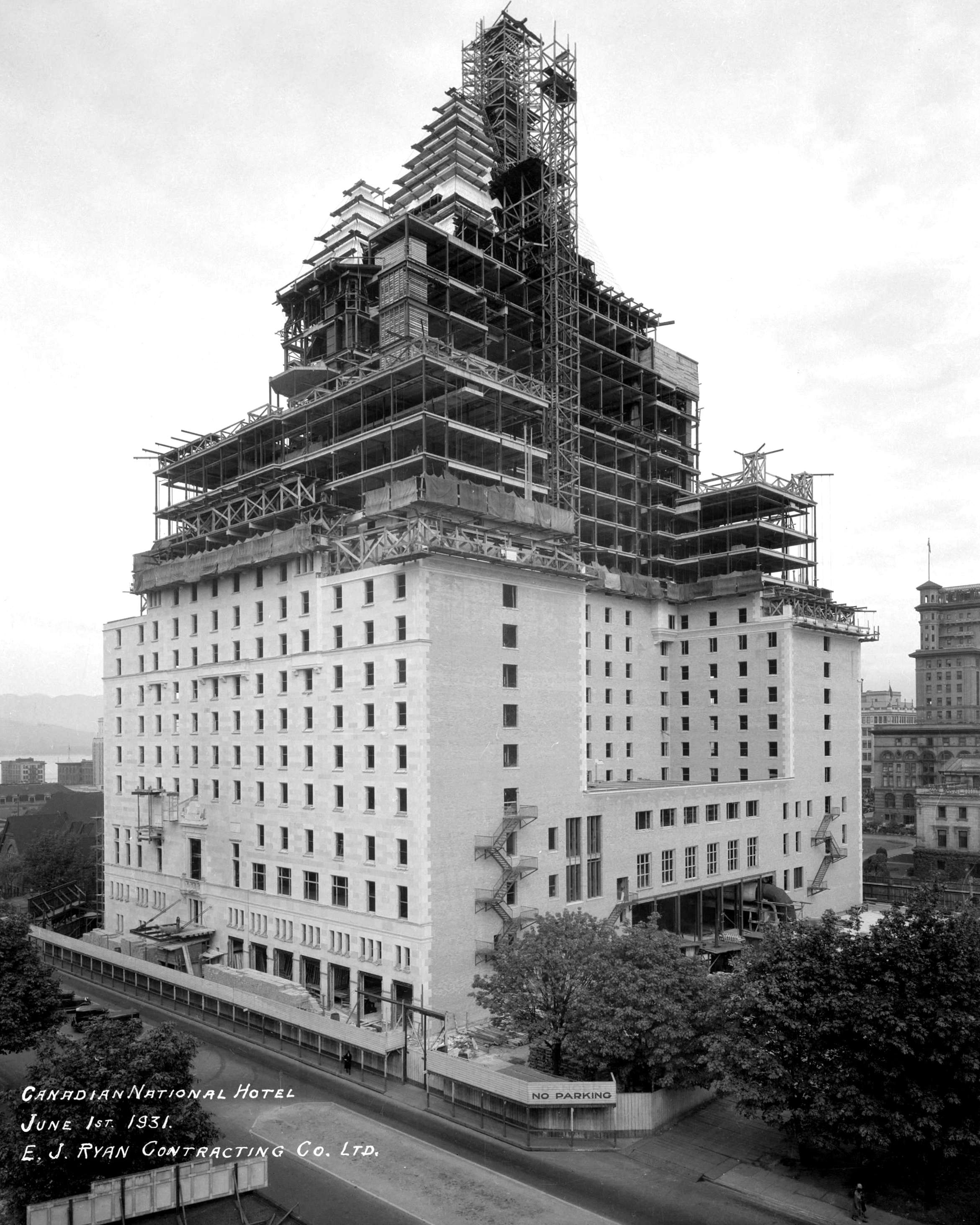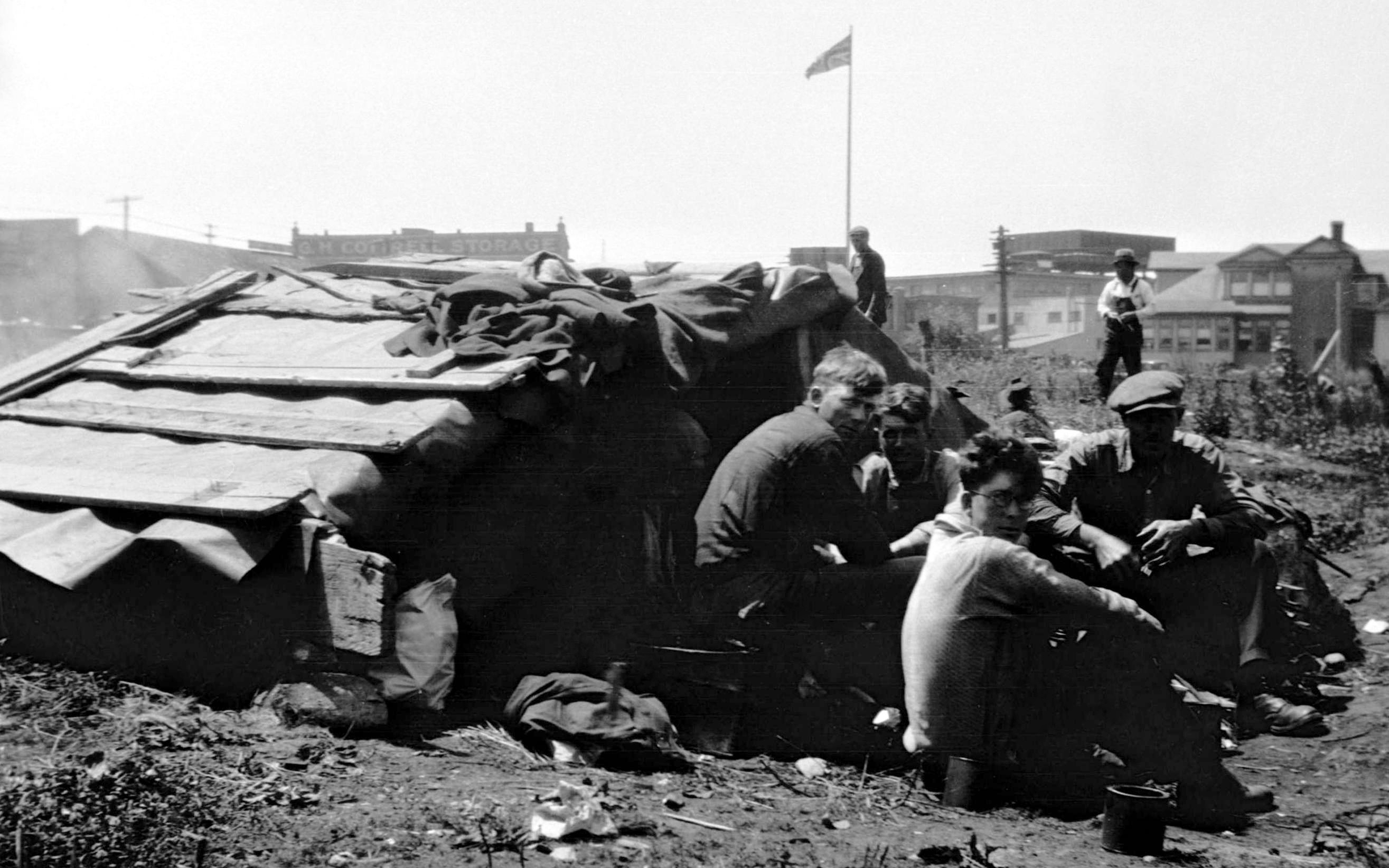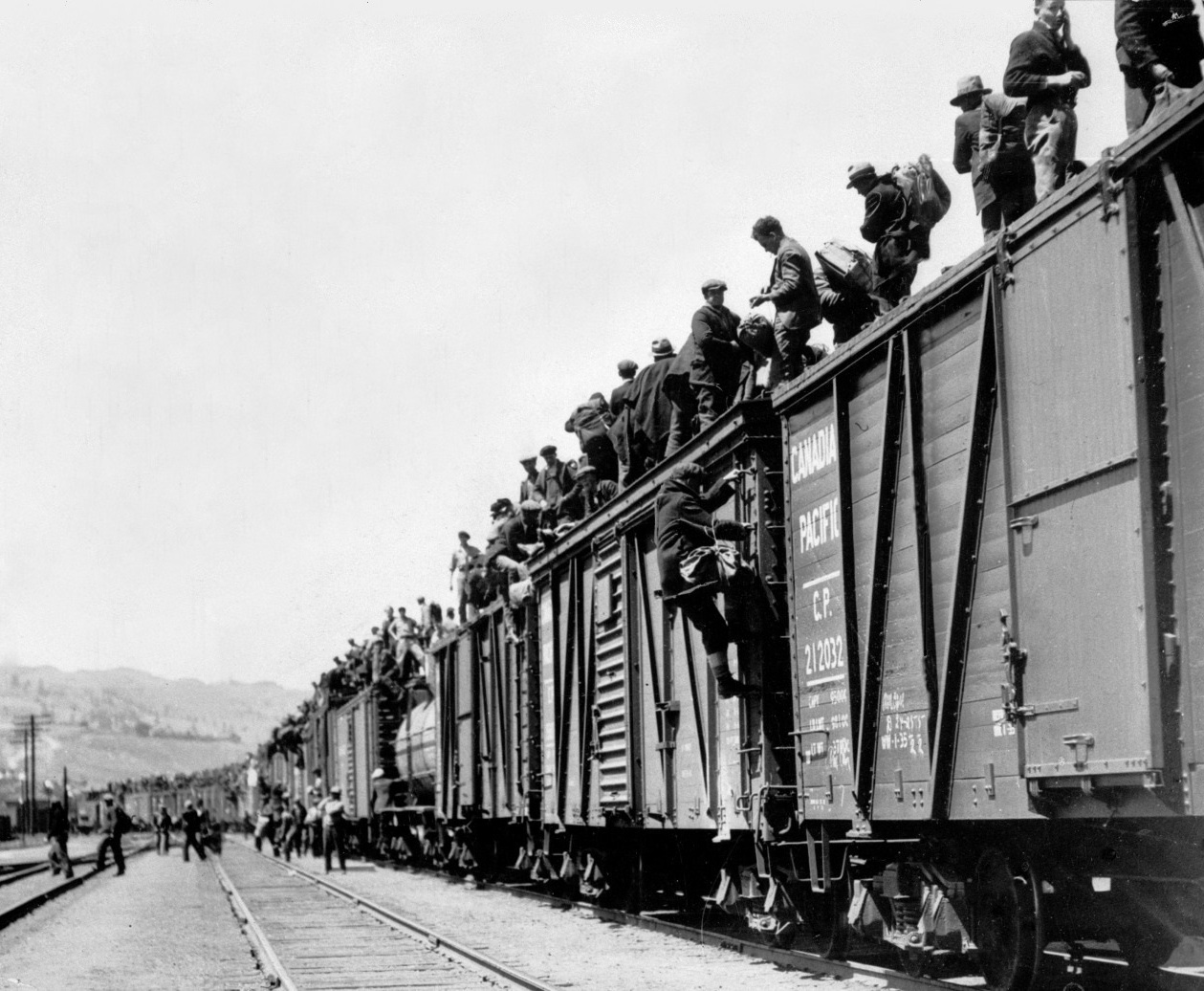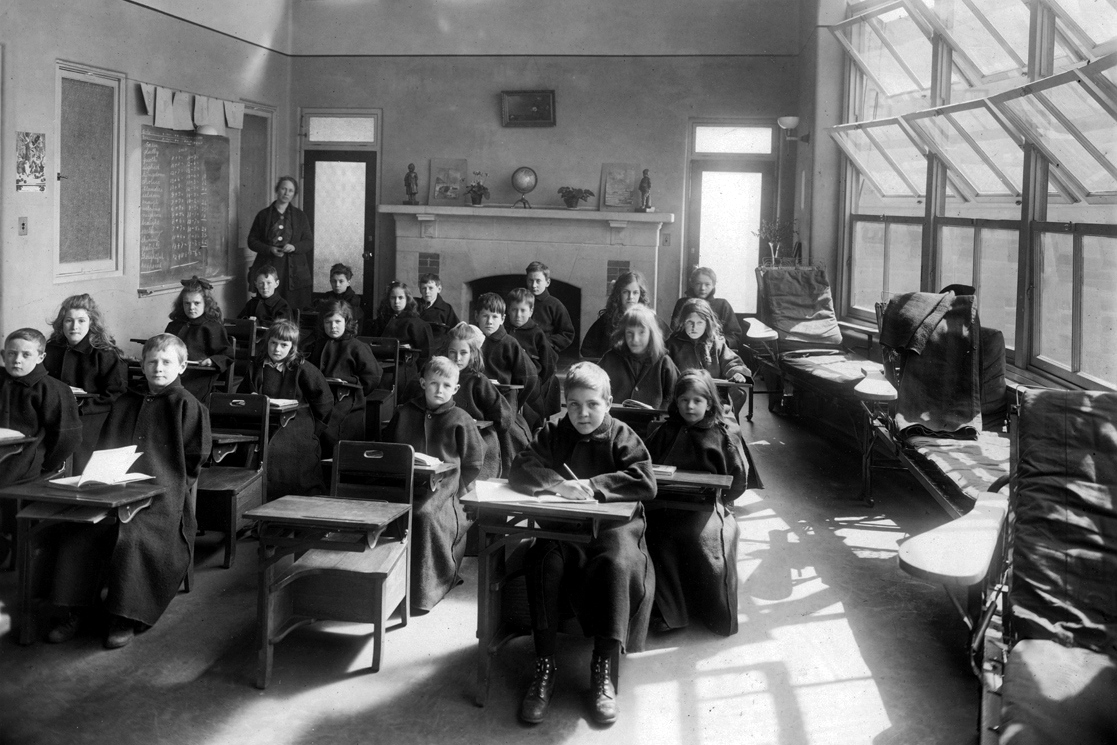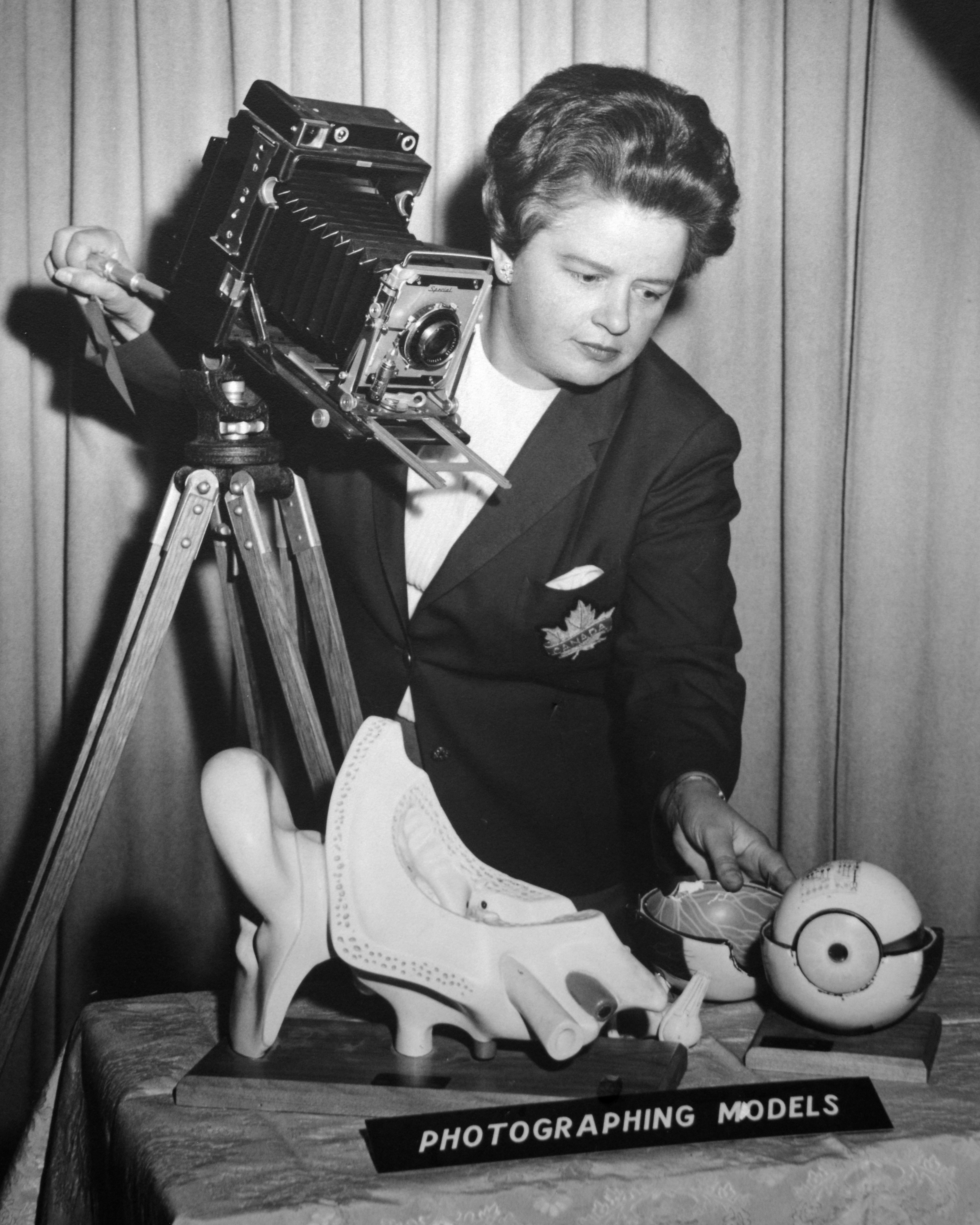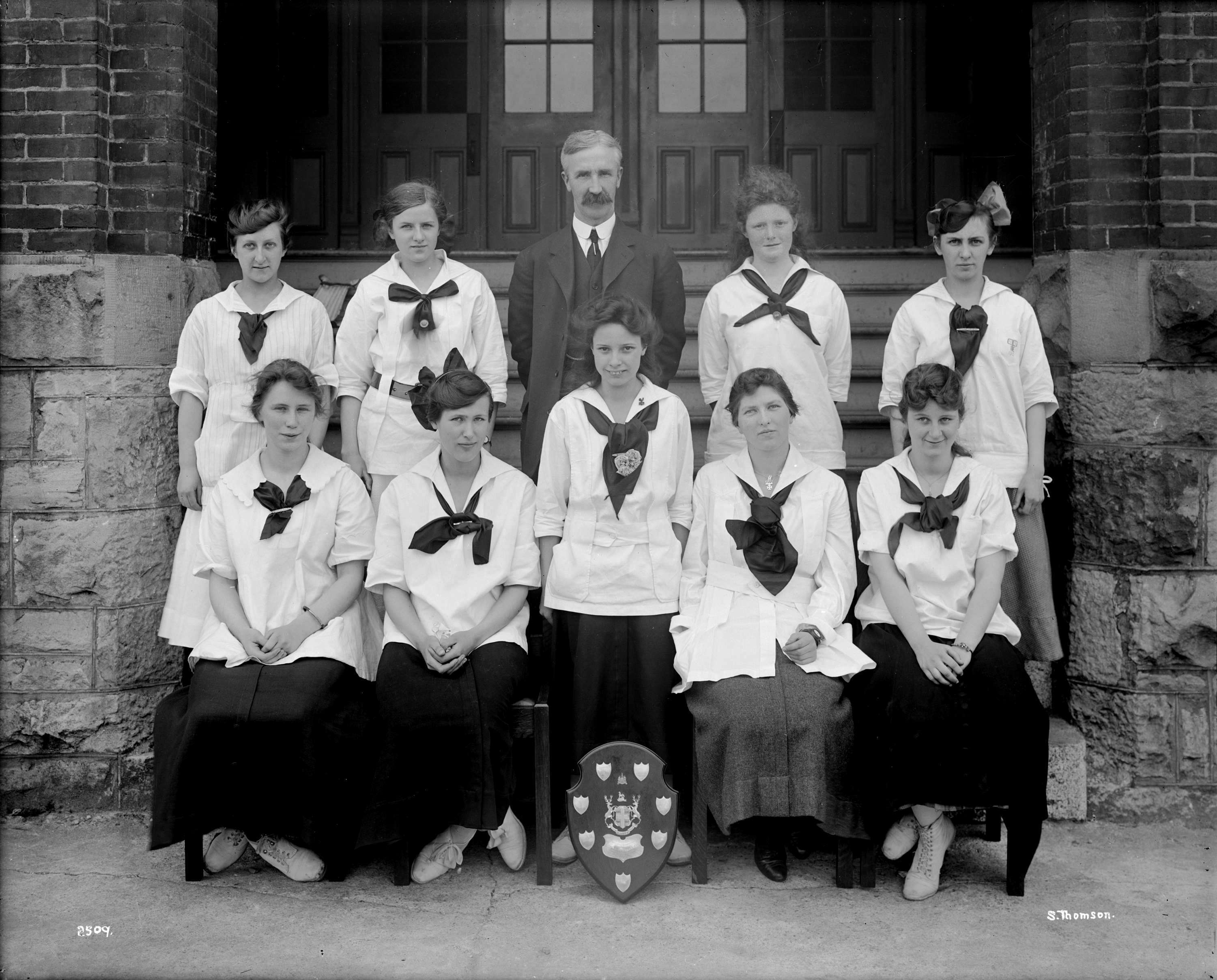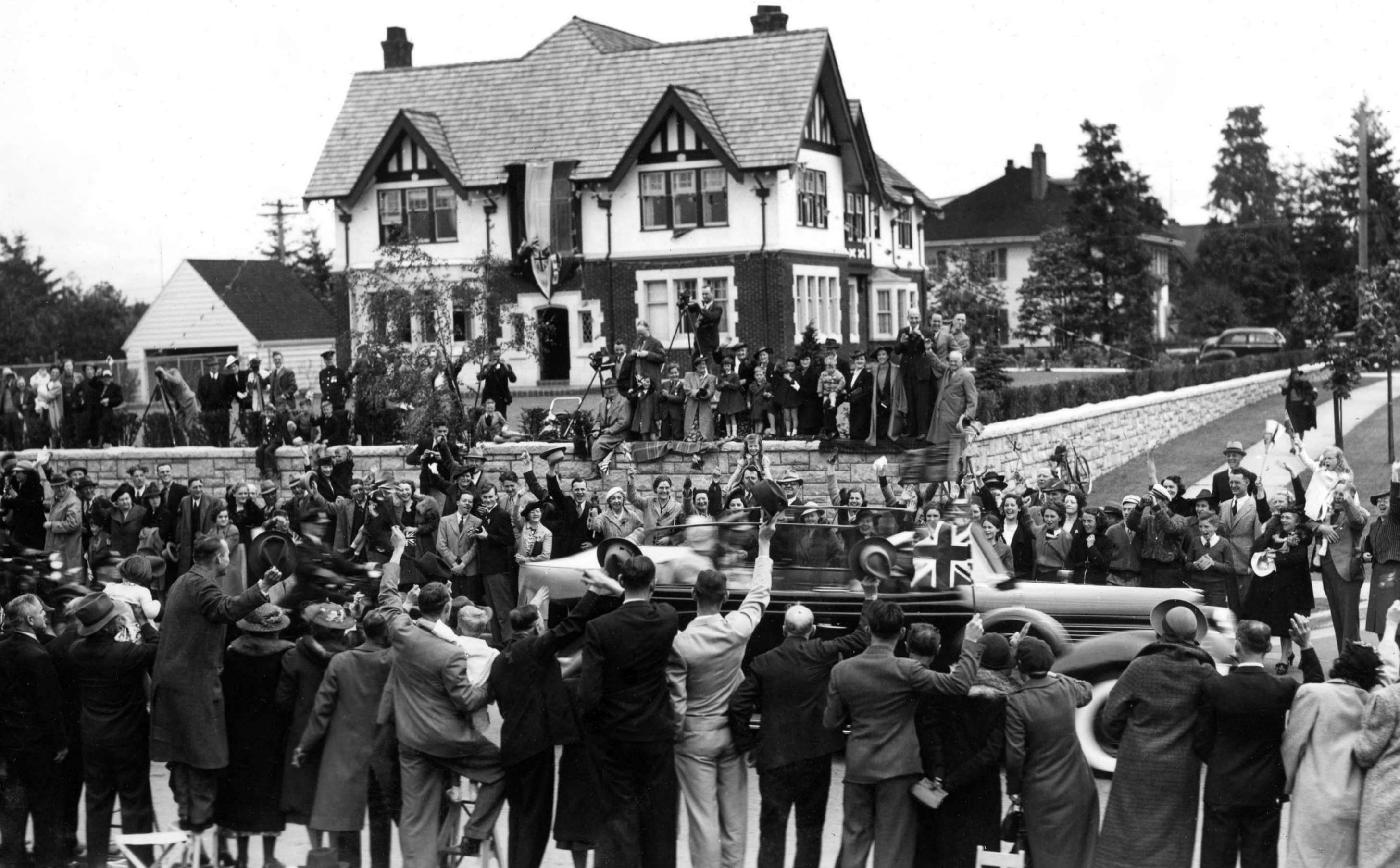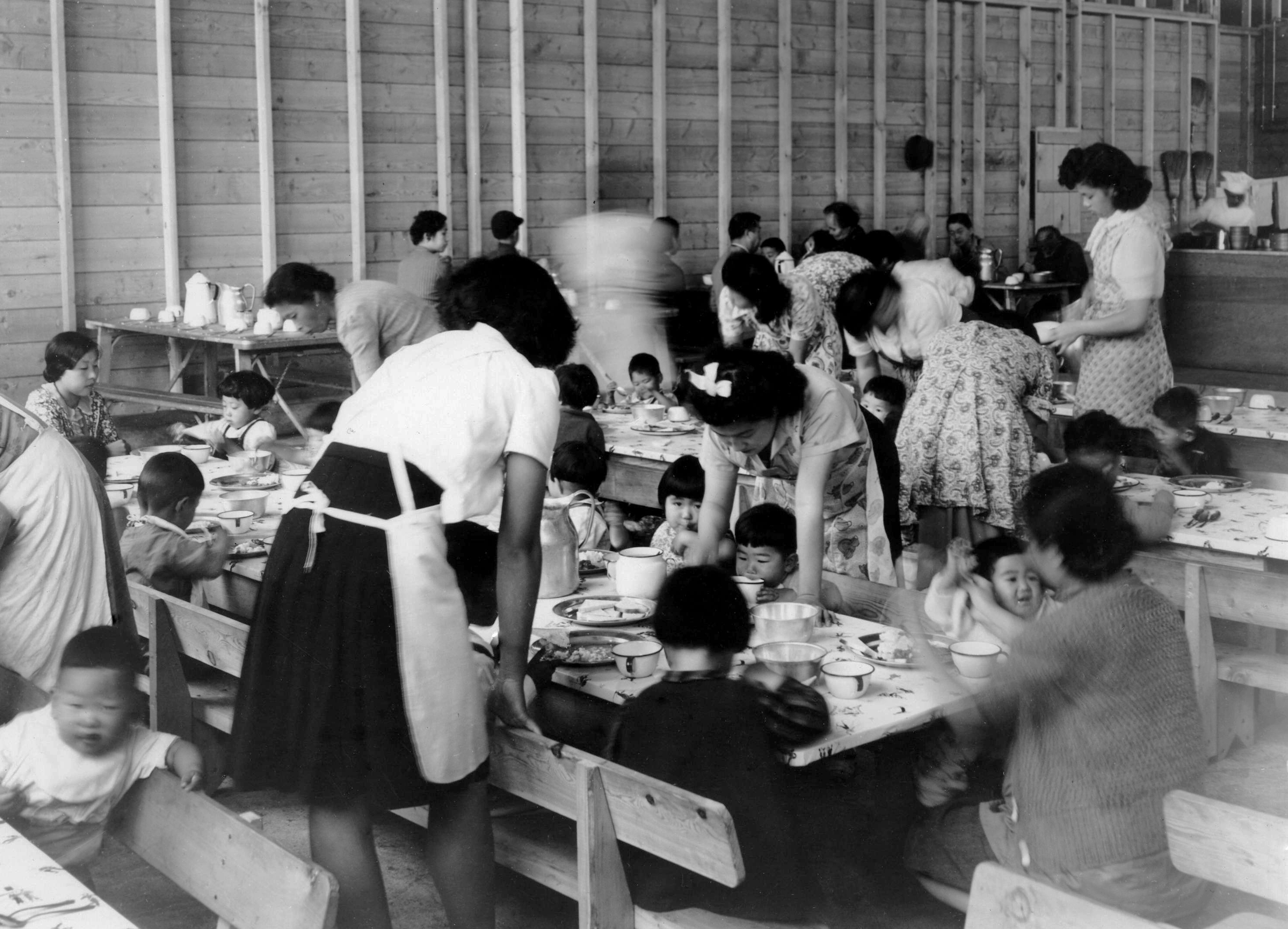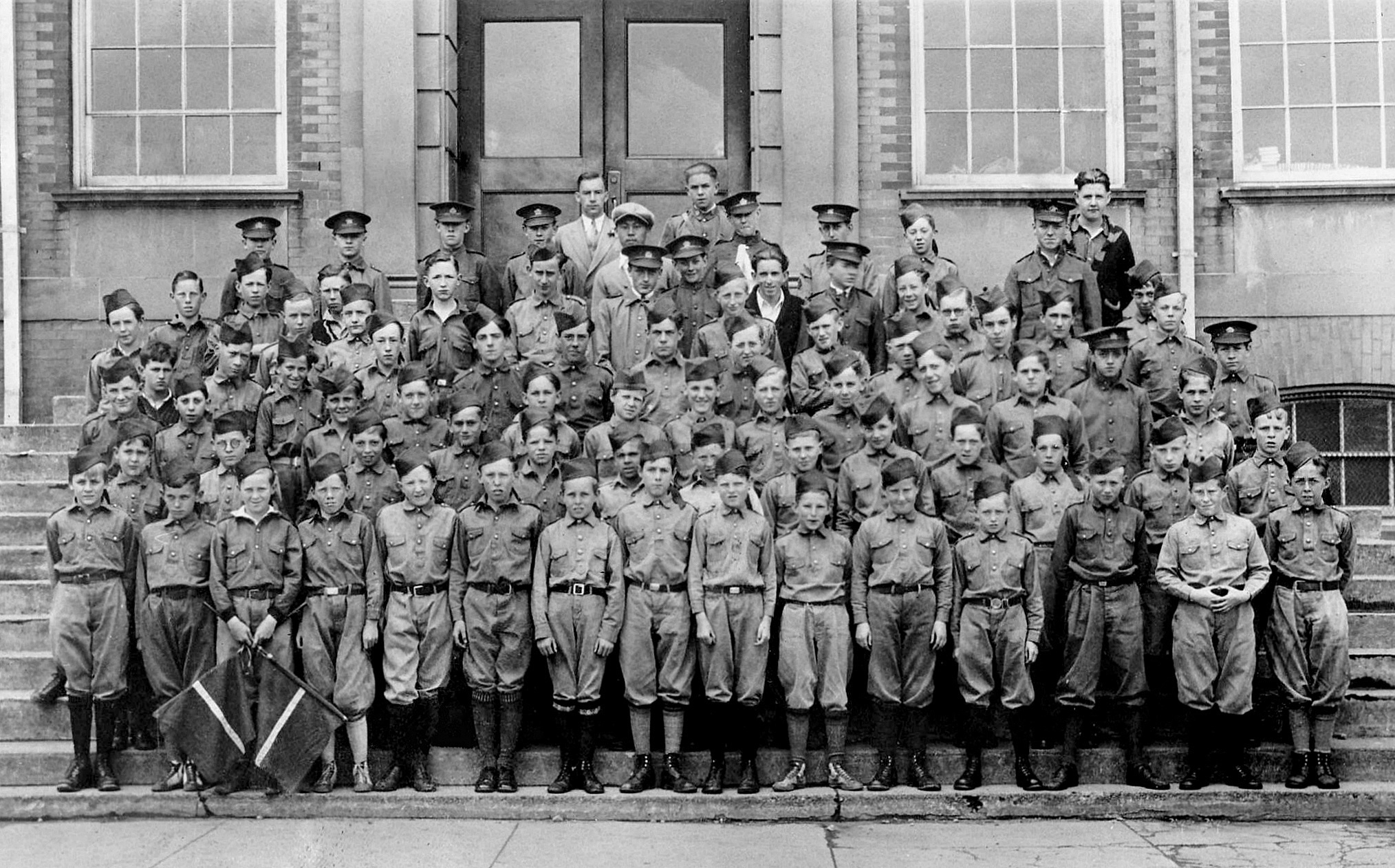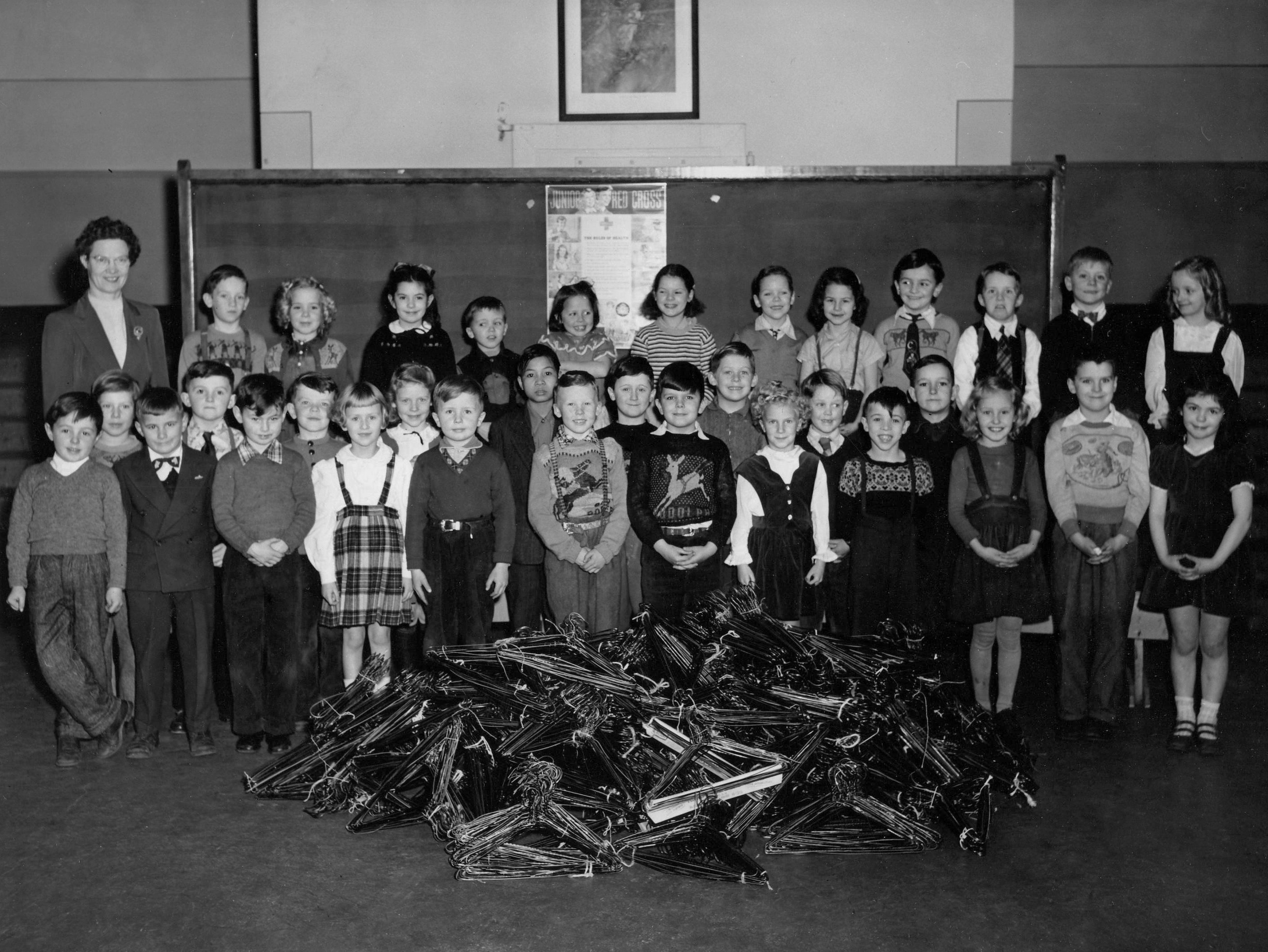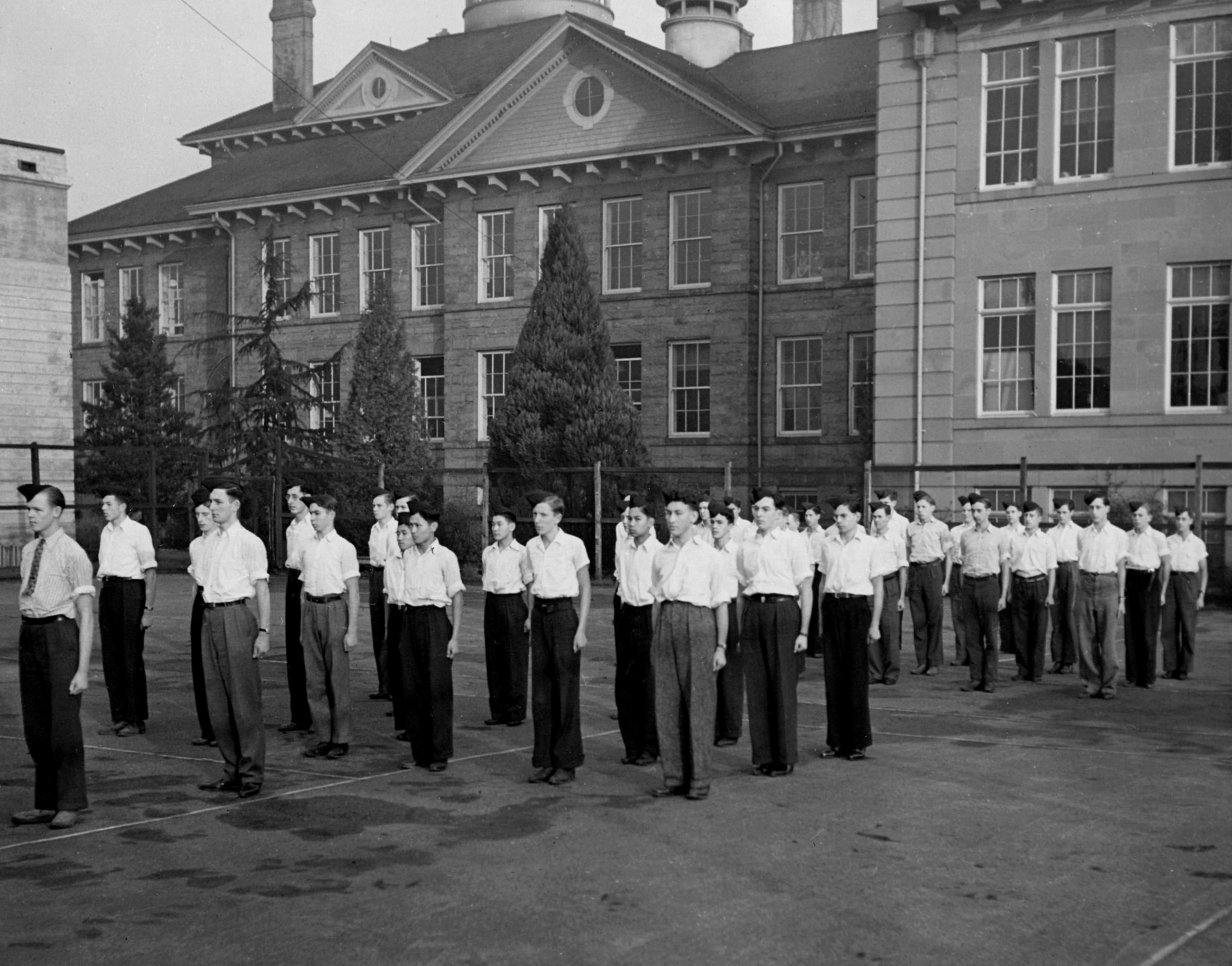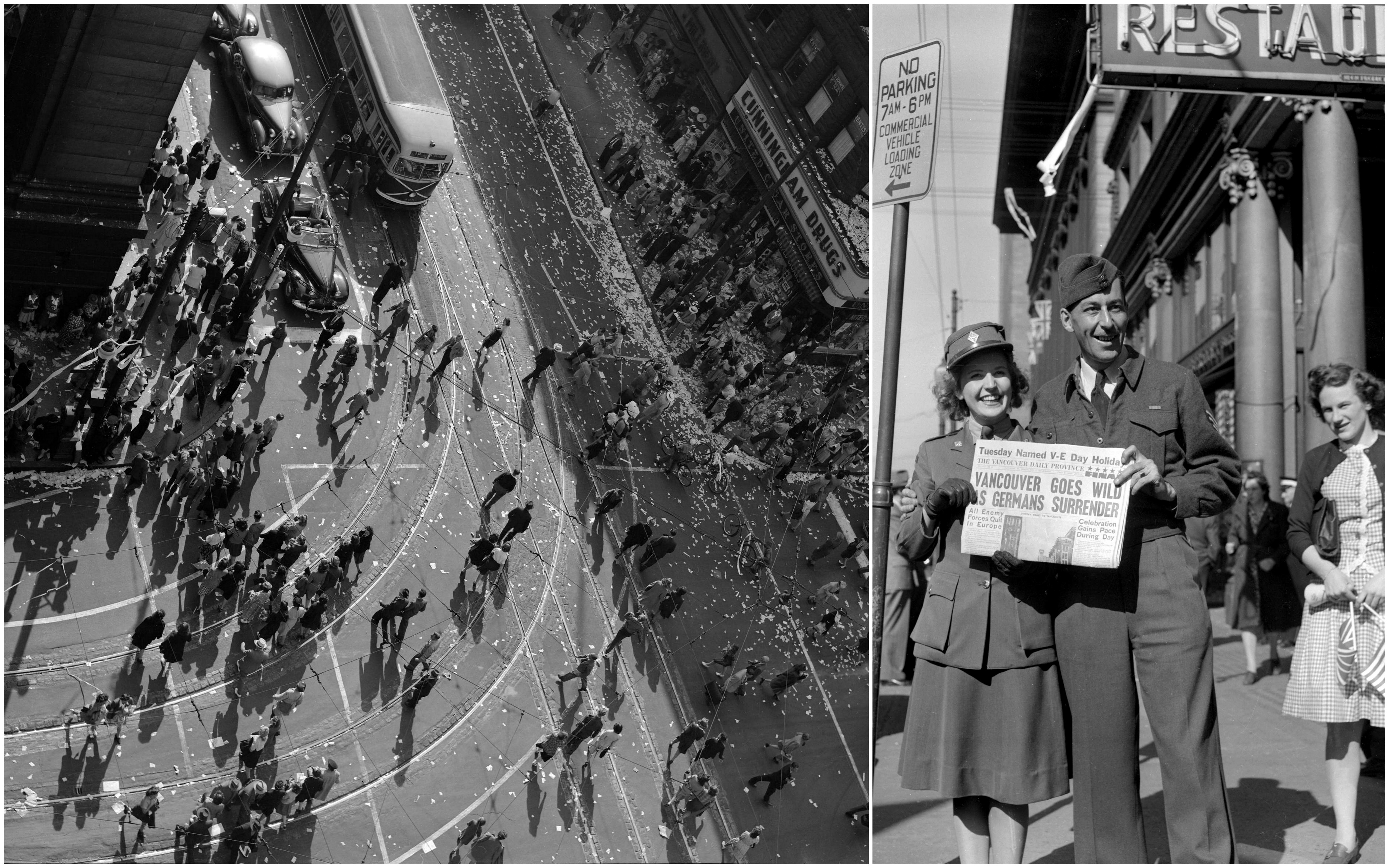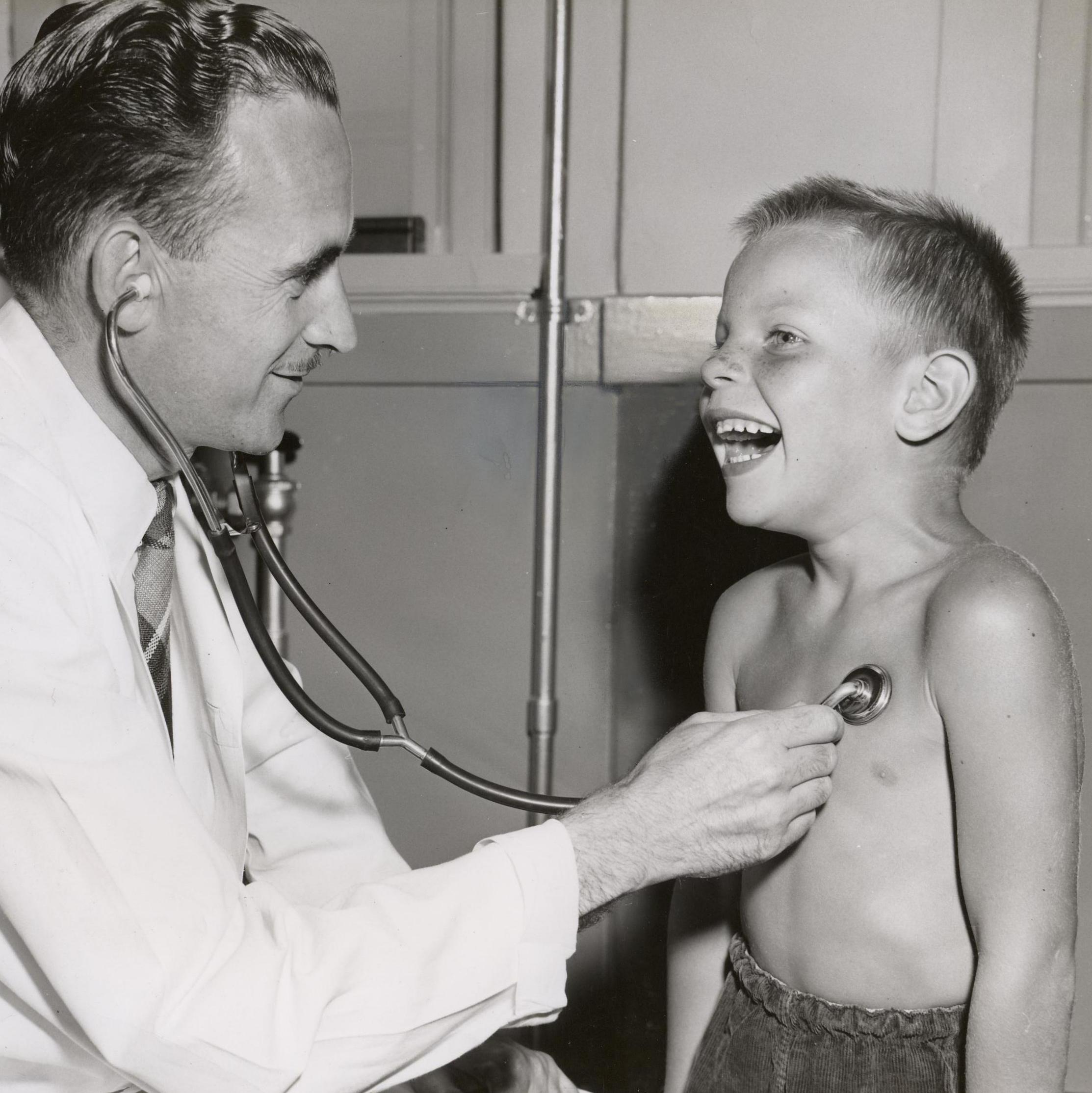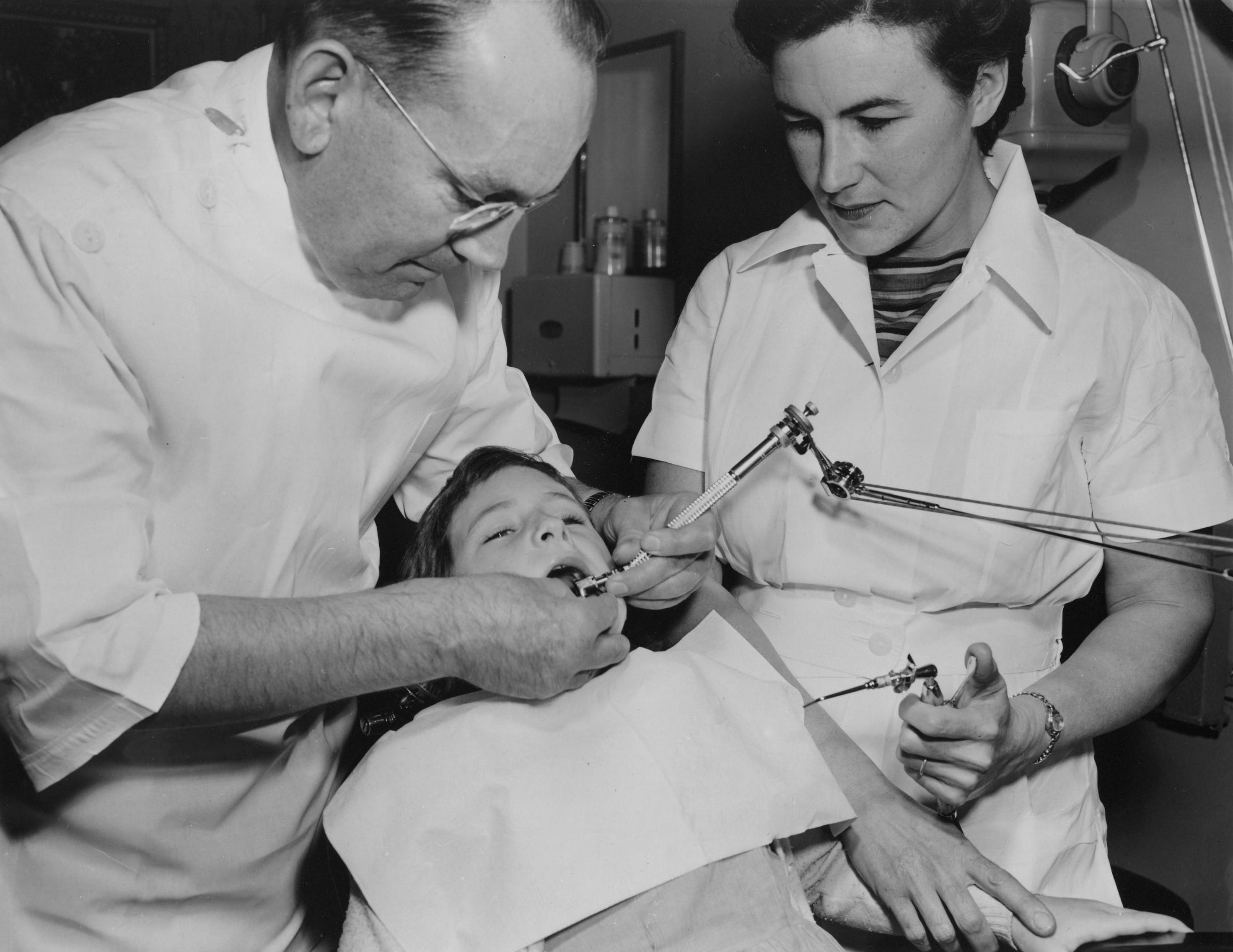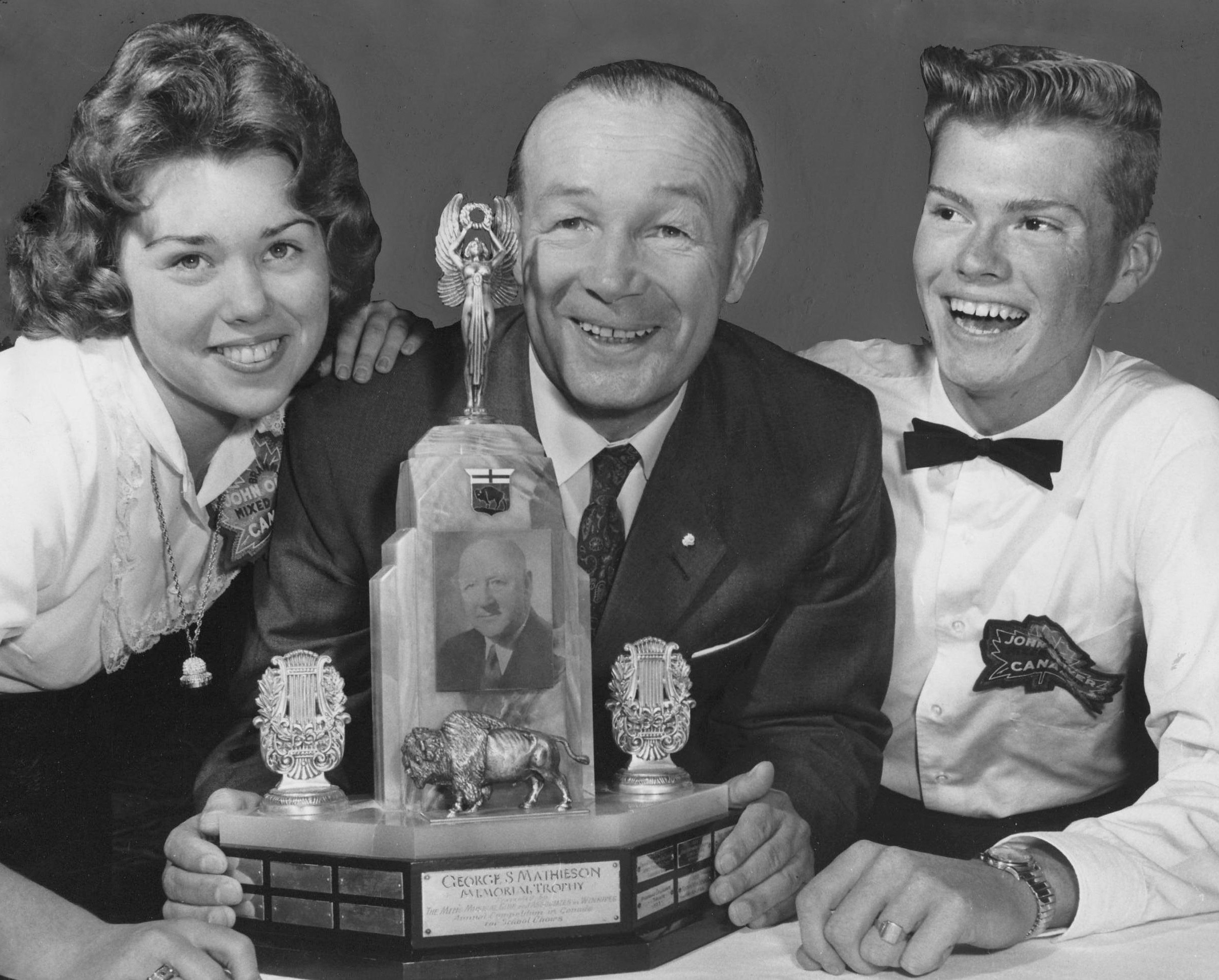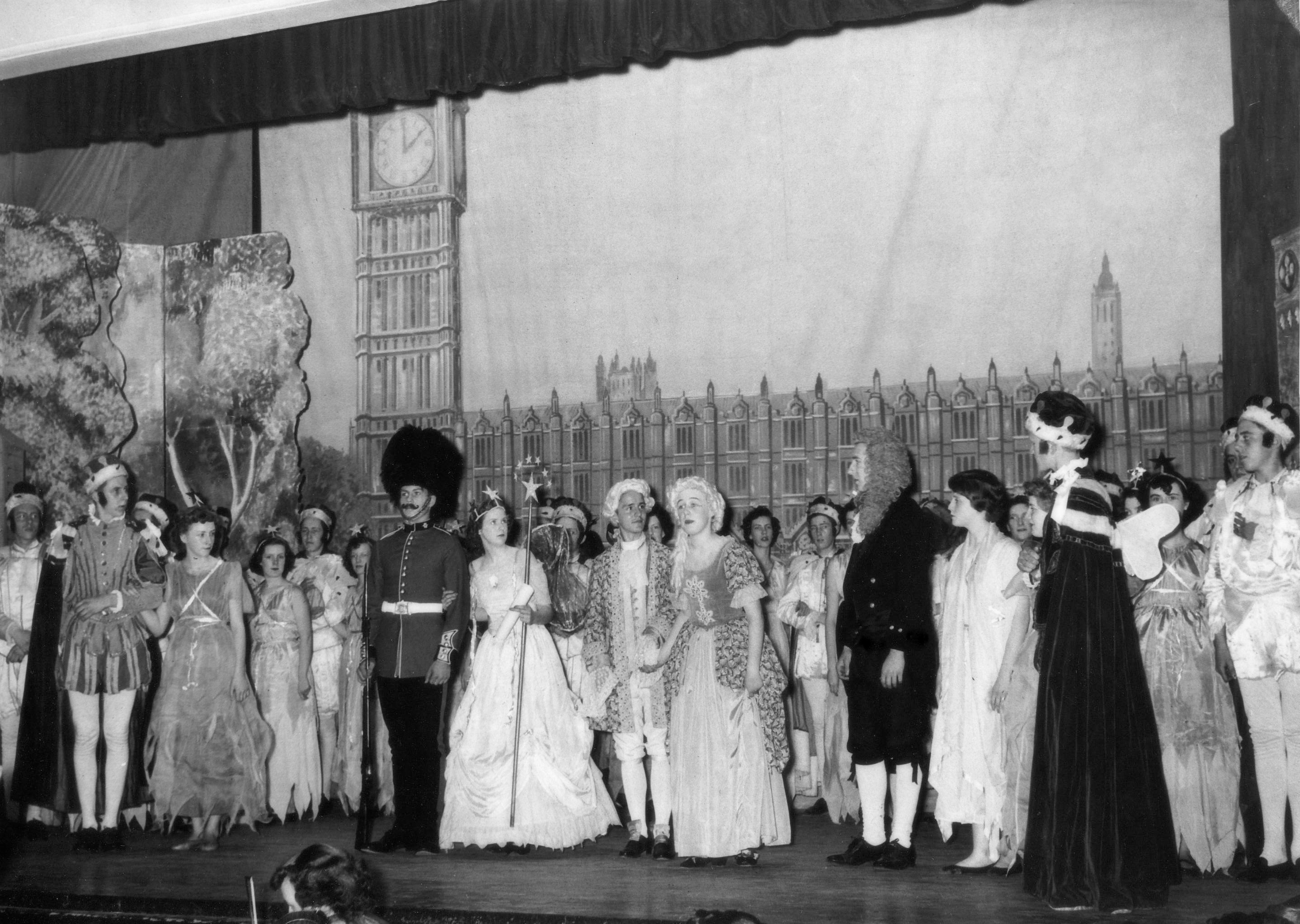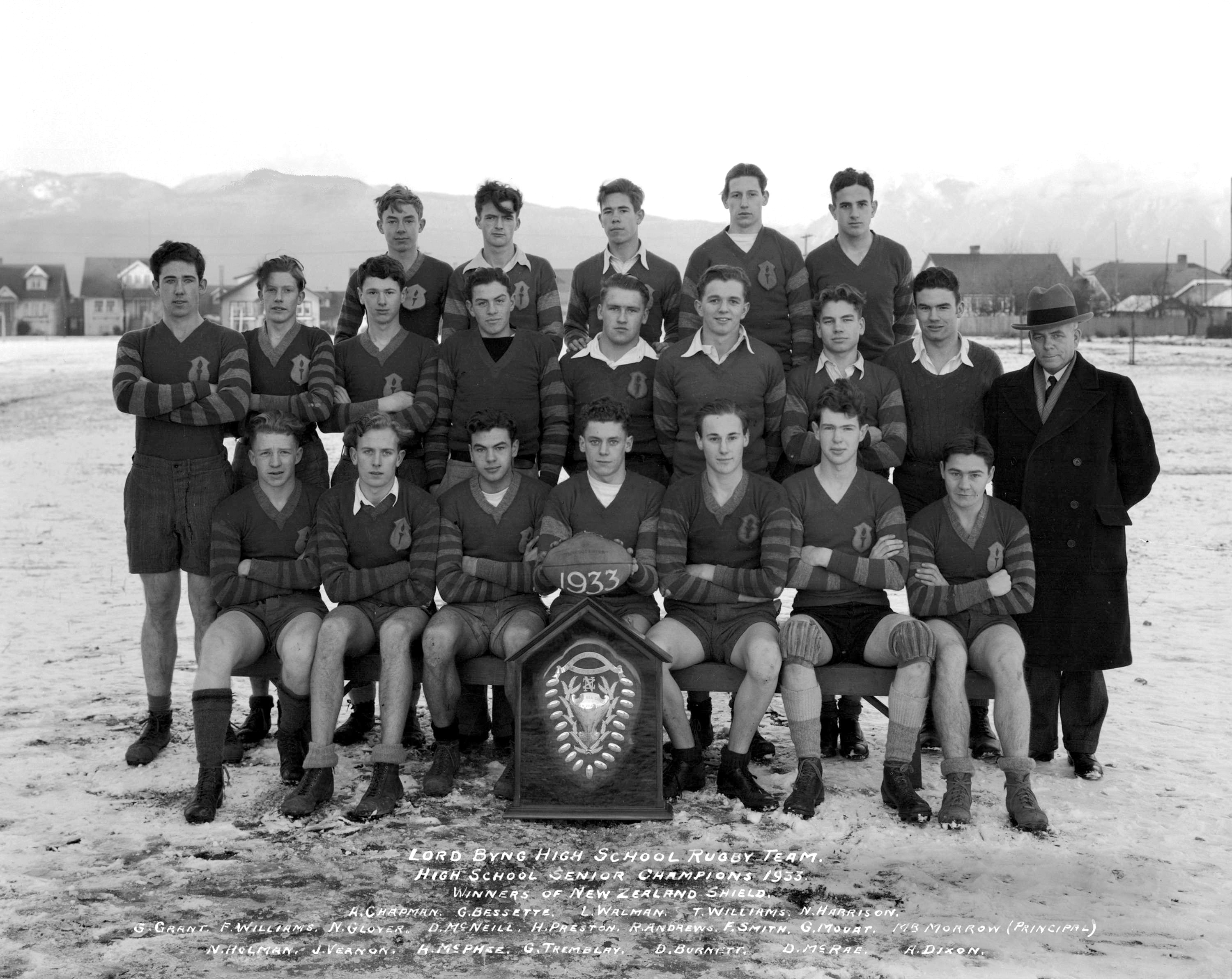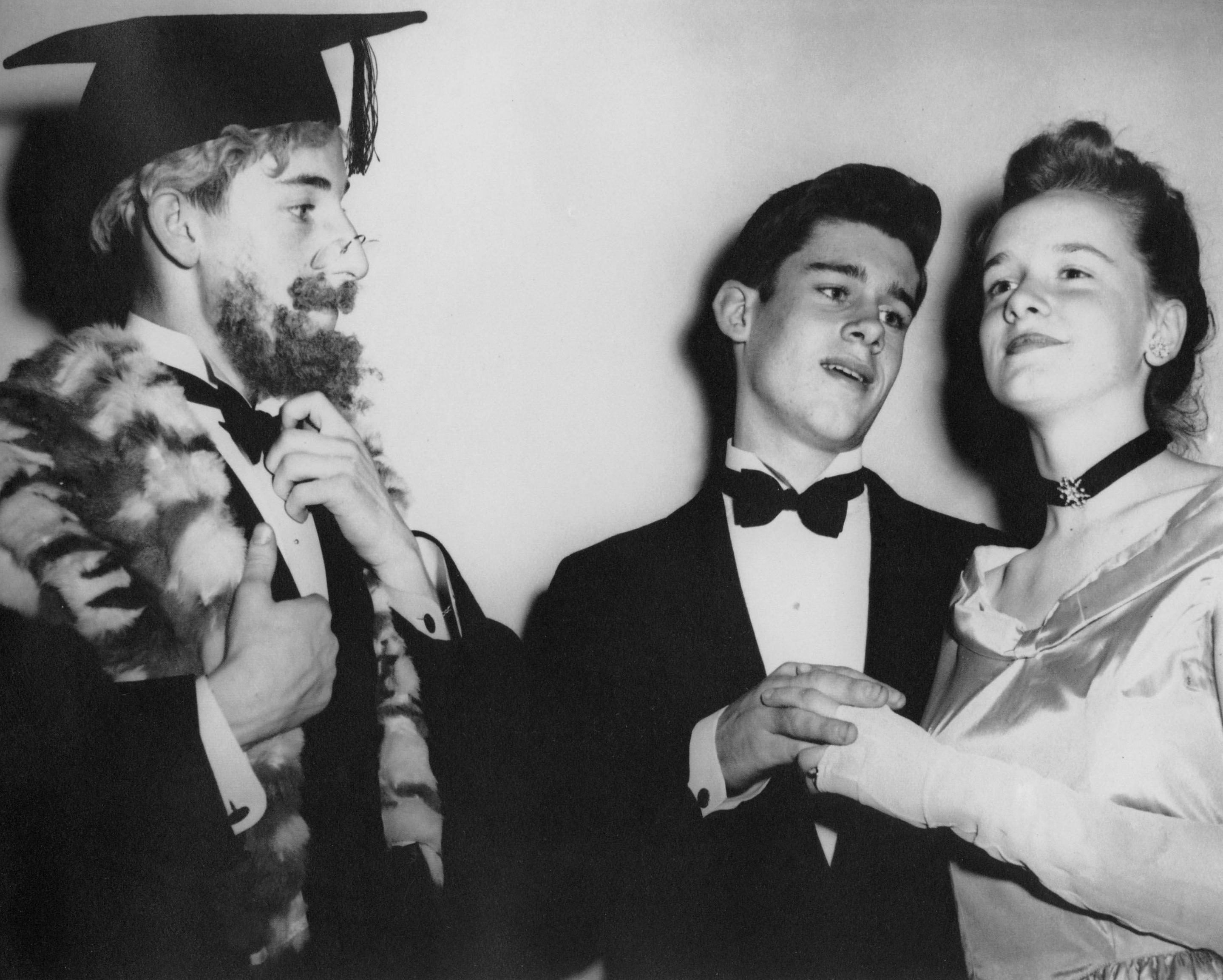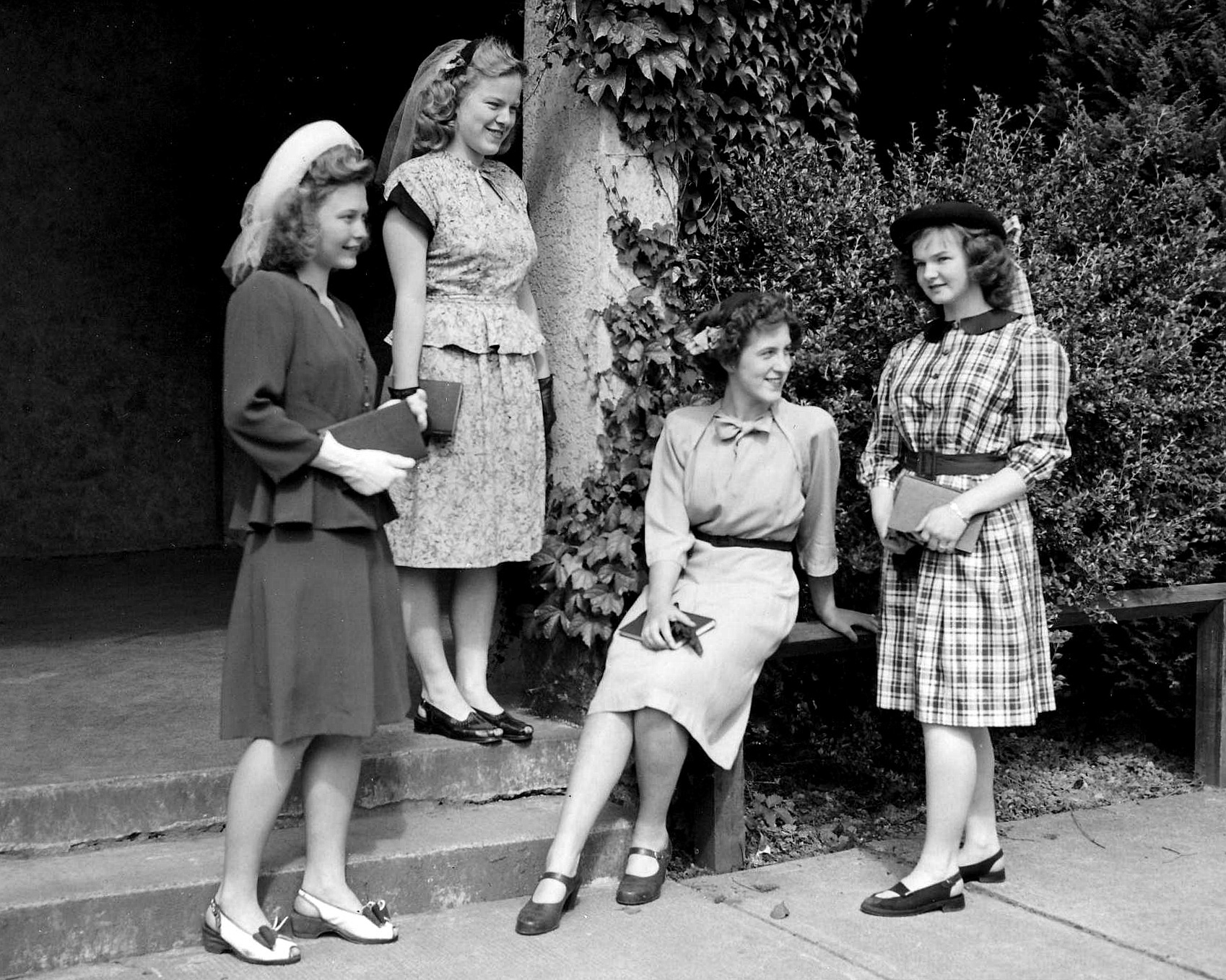Chapter Four: 1931 – 1950
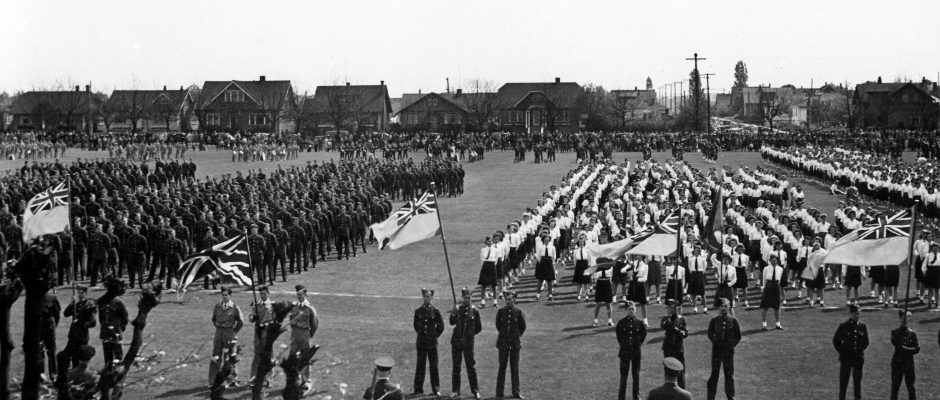
High School Cadets on Parade (1944).
The two decades beginning in 1931 were dominated by two events: a disastrous stock market crash on October 24, 1929, which triggered a lasting global economic depression, and a six-year world war which began on September 01, 1939, following Germany’s invasion of Poland. These events threw Canada into a series of crises that threatened its established way of life. One local result: in stark contrast to the wave of new school construction during the 1920s, no new schools were built in Vancouver during the 1930s and 1940s.
1931 – 1940
- Introduction
The economic downturn had an immediate effect on Vancouver’s population growth. For the entire decade, its population increased by only 10 percent. School enrollment declined steadily from 1936 to 1940. The birthrate dropped dramatically in 1932 and did not recover until 1939.
School enrollment in the Vancouver School District:
Year Enrollment Year Enrollment
1935 39326 1938 38519
1936 39418 1939 37492
1937 39120 1940 36652
Number of children born in the Vancouver School District:
Year Births Year Births Year Births
1931 4373 1935 3588 1938 4227
1932 3689 1936 3478 1939 4365
1933 3323 1937 3950 1940 5091
1934 3409
- Background
Historians have argued that British Columbia suffered more during the Great Depression than any other province, and that Vancouver was more affected than other Canadian cities. Their evidence: B.C.’s economy depended heavily on the export of locally sourced commodities such as lumber, pulp and paper, metals and minerals, coal, and fish; and wheat from the Canadian prairies. Most of these commodities were shipped through the Port of Vancouver.
As prices plunged—often by more than half compared with 1929 prices—volumes slowed dramatically. The result: wages were cut, unemployment soared, and businesses struggled or went bankrupt. Tens of thousands of unemployed young men jumped on trains and travelled across the country in search of work. Many made Vancouver their winter destination due to its ‘warmer’ weather. Squatters’ camps dotted with makeshift shelters sprang up along Vancouver’s waterfront. As conditions in the camps worsened, anger grew and protests broke out.
The new Vancouver Hotel as it looked in 1931. Construction ceased for several years due to the sharp economic downturn in Vancouver. The hotel was not completed until 1939. (Photo credit: Vancouver City Archives)
In 1933, unemployment in Canada peaked at 26.6 percent, a figure that did not include out-of-work farmers and fishermen, and those who had stopped looking for work. That year, British Columbians elected a Liberal government led by Duff Pattullo. A new party, the Cooperative Commonwealth Federation (the forerunner of the New Democratic Party) formed the opposition. To relieve the plight of the unemployed, the Pattullo government launched a number of public works projects.
1931: Squatters camp, Vancouver waterfront. (Photo credit: Vancouver City Archives)
At the federal level, the Conservative government of R. B. Bennett responded to the unemployment crisis by setting up ‘relief camps’ in remote locations camps where young men labored on projects such as road building, tree planting, and small construction jobs for 20 cents a day (plus room and board, and medical care.) Poor conditions in these camps led to protests organized by the Relief Camp Workers Union, which had close ties with the Communist Party of Canada.
In 1935, growing unrest led to work stoppages in the camps, and major strikes and protests in Vancouver. These culminated in the ‘On-to-Ottawa’ Trek, which saw hundreds of unemployed men jumping freight trains in Vancouver and heading east. Their journey came to an end in Regina, where RCMP riot squads intervened with force to end the trek. More than a hundred Trekkers and supporters were arrested; many more suffered injuries.
The ‘On-to-Ottawa’ trekkers did accomplish something. Their efforts won public sympathy, and the Bennett government was defeated in a national election held later in 1935. The new Liberal government shut down the federal relief camps, and the stage was set for the expansion of federal social programs in later years.
1935: Relief camp protesters jump a freight train at Kamloops, B.C. (Photo credit: Vancouver City Archives)
- Impact of the Depression on the Vancouver School District
The Vancouver School Board wrestled with a host of problems created by the decline in the local economy:
In 1933, the city ordered the Vancouver School Board to drastically reduce its budget by $400,000. This was followed a year later with an order for an additional cut of $500,000. The school board objected strenuously to this additional reduction in expenses. After considerable debate, the school board and council agreed to meet half way. The board cut a total of $650,000 from its $2 million operating budget—under considerable protest…
Programs were eliminated and salaries were reduced to meet the shortfall. The average salary of an elementary teacher in 1931 was $1801 per year. By 1934 the average teacher was making $1300.The average secondary teacher was receiving $2676 in 1931. By 1934 the average salary for a secondary teacher was $1995 per year.
Here is a list of programs and services cut in 1933:
- Dental department eliminated
- Medical department – one-third eliminated and all social service work cut off.
- Open-air school, attended by 72 Children, ordered closed
- Teachers withdrawn from Preventorium, general Hospital, Crippled Children’s Hospital, and Detention Home.
- Sight-saving classes discontinued.
- Special classes, organized for those unable to cope with regular studies, were reduced by increasing the number of pupils in each class, thus reducing the number of teachers employed.
- Home economics and manual training classes eliminated throughout the district.
- Number of supervisors cut in half. These employees were engaged in supervising music, physical training, art, home economics, manual training, etc.
- Bureau of measurements curtailed to the extent of an absolute minimum of records and statistics.
- Drastic cuts made in free supplies to pupils.
- Architect transferred to part-time basis at less than one-quarter salary
Open Air School: 1919 – 1932. Opened by the Rotary Club for children predisposed to respiratory disease. Closed in 1932 as a cost-saving measure.
Follow this link for more information on the Open Air School:
VANCOUVER’S OPEN AIR SCHOOL
The parent-teacher associations began raising funds for their schools, supplying free milk and hot lunches to students, and providing sports equipment and library books. They organized “self-help” groups so unemployed parents could learn crafts such as carding and dying wool and rug and quilt making.
Many children didn’t attend school regularly and it was difficult to keep them in school. They were expected to look for work to help support their families. Low paying jobs lured some into leaving at an early age. Work at the shipyards paid $1 an hour and students who weren’t working were envious of those who were.
Excerpts from “Glancing Back” Reflections and Anecdotes on Vancouver Public Schools
- School & Classroom Culture; Instructional Practices during the 1930s
Very little, for a number of reasons, changed in terms of how instruction happened…
Within this broad context, individual teachers’ personalities made a tremendous difference to students. Most students remember some of their teachers, often for their ‘special’ talents, such as being able to write with both hands in multi-coloured crayons. In students’ eyes, fairness—i.e., an equal application of the rules of the rules in a rule-bound environment—was an important measure of a teacher. Particular events, such as the Christmas Concert and Sports Day, stand out. Many Vancouver schools included among their staff, teachers who spent almost their career (as many as 45 years) at a single school. Likewise principals, once appointed, tended to stay. This meant that staff and school were closely identified with individual personalities. It is not unusual to find photographs of long-standing principals in the administrative offices or prizes named in honour of long-serving teachers. In fact it is at the level of individual elementary schools that the memory of the labour of female teachers—who dominated the workforce—is most evident.
Excerpt from Vancouver Schools – Establishing Their Heritage Value
- The Vancouver School Board creates a ‘Visual Education Department’
At the beginning of the year 1937, the Board of School Trustees realized that a school system the size of Vancouver would have to face, in the very near future, the problem of planning for the use, collection, and distribution of visual aid.
To avoid needless duplication and unnecessary expense, Mr. J. R. Pollock, of the John Oliver High School staff, was appointed on a half-time basis January 1st, 1937, to organize a Department of Visual Education for the Vancouver Schools.
During the summer holidays, Mr. Pollock was given the opportunity of visiting some of the cities where visual education departments have been established for some time. Part of his time was spent in studying conditions in the vicinity of Hollywood, where he attended a convention of the American Institute of Cinematography and was honoured by being nominated to the Convention Executive. In this way he was actually introduced to the motion picture industry, where he was permitted to study in their laboratories and studios their particular methods of production.
The year (1940) has been one of great expansion in the Visual Education Department. We have been very fortunate in having a large number of our films of an industrial and commercial nature donated to us. Several have also been placed on loan. The schools themselves, with the assistance of the Parent –Teacher organizations, have been able to finance the purchasing of equipment for this department
In addition to the regular circulation-work of the Visual Education department, microscope slides and photomicrographs for use in the teaching of Biology have been constructed for the high schools.
Excerpts from the reports of H. N. MacCorkindale, B.A. Superintendent of Schools, Vancouver, to B.C.’s Ministry of Education.
Vancouver School Board Audio Visual Department (1940)
Marjean Gibson – long-time member of the VSB Visual Education Department.
- History of Inter-High School Sports to 1940
In September, 1908, when the East End High School, now Britannia, challenged a junior team from Vancouver High School to a rugby match, it was not surprising that most of the East End players had learned the game at the old school. This game, played on the Vancouver High School field, was the first in which representative teams of two Vancouver high schools competed. Junior rugby between the two schools continued until the season of 1914-15, when King George High School joined to form a three school league.
Vancouver High School Rugby Team (1907-08)
The High School Sports’ Meet, which had been an unfailing success since its inception in 1903, made a new beginning as an Inter-High Meet when Britannia joined King Edward High school at Brockton Point in May, 1912. This Sports’ Meet is notable also as being the first in which girls took part as competitors.
By 1914 four girls’ events had been added to the sports programme, the 75-yard dash—open, junior and juvenile, and an open senior relay race. In 1916, three more were included: throwing the baseball, throwing the basketball, and hitting the hockey ball. In 1940 more than one-third of the total of 34 events was for girls.
King George High School girls relay team (1916-1917)
The High School Sports’ Meet has travelled a long way from its beginnings in 1903, when boys of Vancouver High School and College and representatives of Columbia College, established initial records. Today, athletes of both sexes from nineteen high schools compete under almost perfect conditions at Hastings Park, and the Sports Meet provides a spectacle of color and efficiency unsurpassed in Canada.
Excerpts from FIRST FIFTY YEARS 1890–1940 VANCOUVER HIGH SCHOOLS
Vancouver and District Inter-High School Track Meet. Top: 1932; Bottom: 1950.
- Royal Tour: King George VI and Queen Elizabeth (1939)
This tour marked the first time that Canadians were visited by their reigning monarch. The King and Queen arrived at Quebec City on May 17 aboard the Canadian Pacific ship RMS Empress of Australia. From there, they traveled west across Canada by train, arriving in Vancouver on May 29. The royal couple spent most of the day touring Vancouver, and North and West Vancouver, by motor car.
After a brief visit to Victoria, the royal couple traveled east through the United States to Canada’s Maritime provinces, and finally, to Newfoundland (not yet a province of Canada.) They departed from Halifax June 15 aboard the RMS Empress of Britain.
This tour came at a time when the threat of war was hanging over Europe. The aim of those who planned the tour was to strengthen the bonds Canadians felt towards Great Britain by giving them the opportunity to feel a personal connection to their monarch. The tour would also celebrate the fact that Canada had achieved the status of an independent kingdom in 1931, with the adoption of the Statute of Westminster by the British Parliament. This statute ended Britain’s authority to pass laws affecting Canada except on matters agreed to by both countries. By all accounts the tour was a great success. The King and Queen were met by cheering crowds in all parts of the country.
Less than three months after the Royal tour ended, war broke out in Europe.
Date: August 1939 Banners on the David Spencer Department Store on West Hastings Street celebrate the 1939 Royal Visit to Vancouver. Photo Credit: Vancouver City Archives.
Date: August 1939 Vancouverites cheer King George VI and Queen Elizabeth as their cavalcade passes by. Photo Credit: Vancouver City Archives
The War Years: 1939 – 1945
- Introduction
Memories of World War One must have been fresh in the minds of many in Vancouver on the day the Second World War broke out. Despite possible misgivings, the vast majority of Vancouverites were not deterred from supporting the war effort. And, as before, Vancouver schools played an important part in the war effort. One difference was that for the first time, the people of Vancouver experienced being a possible target of attack or invasion.
- Background
The Second World War began with German’s surprise invasion of Poland starting on September 01, 1939. Canada declared war against Germany on September 09, six days after Great Britain’s declaration of war. The first elements of the Canadian army began arriving in England in early 1940, where they assumed duties as a defence force against a possible German invasion of southern England.
During the first two years of the war, Canadian troops saw action only once: as the major contingent of a force which made an abortive attack on the coastal port of Dieppe in northwest France, in 1942. In 1943, Canadian forces took part in the invasion of Sicily and later, the Italian mainland. In 1944, Canadian troops played a major role in the invasion of German-occupied France. Canadian aircrew took part in bombing raids against German targets in Europe, and Canadian naval forces played a key role in keeping shipping lanes open between Canada and Great Britain.
Until the end of 1941, the realities of war must have seemed very far away for Canadians living along British Columbia’s coast. In fact, the war had given the provincial economy a big boost. The forestry and mining industries were growing rapidly. In North Vancouver, Burrard Dry Dock Ltd. was on its way to become Canada’s busiest shipyard. During the war, it built more than 100 freighters, as well as minesweepers, corvettes, landing craft, and maintenance ships. At its height, it employed more than 14,000 workers.
On December 07, 1941, Japanese planes made a massive surprise attack on the United States Pacific Fleet at Pearl Harbour. The same day, Japanese forces began attacking the British possessions of Malaya, Singapore, and Hong Kong. That evening, Canadian Prime Minister Mackenzie King announced the intention of the Government of Canada to declare war on Japan. On December 08, King George VI approved Canada’s declaration of war.
Although Japan and the Pacific Coast of North America were separated by the vast expanse of the Pacific Ocean, there was genuine fear that Japanese forces might stage major attacks on American and Canadian cities and other targets. The Japanese encouraged these fears by:
- launching large balloons armed with incendiaries across the ocean to start forest fires.
- using deck guns mounted on submarines to bombard targets such as lighthouses.
- occupying the Alaskan islands of Attu and Kiska with ground troops.
These fears, coupled with long-standing anti-Asian views held by many British Columbians led the Canadian Government to order the internment of all people of Japanese ancestry living in the coastal areas of British Columbia.
1942: Japanese Canadian women serving children a meal in Hastings Park. (Photo credit: Vancouver City Archives)
The order in 1942 to leave the “restricted area” and move 100 miles (160 km)inland from the West Coast, was made under the authority of the War Measures Act/ this order affected more than 21,000 Japanese Canadians. Many were first held in the livestock barns in Hastings Park. (Vancouver’s Pacific National Exhibition grounds) and then were moved to hastily-built camps in the BC (British Columbia interior. At first, many men were separated from their families and sent to road camps in Ontario and on the British Columbia/Alberta border. Small towns in the British Columbia interior—such as Greenwood, Sandon, New Denver, and Slocan—became internment quarters mainly for women, children, and the aged. To stay together, some families agreed to work on sugar beet farms in Alberta and Manitoba, where there were labour shortages. Those who resisted and challenged the orders of the Canadian government were rounded up by the Royal Canadian Mounted Police and incarcerated in a barbed-wire prisoner-of-war camp in Angler, Ontario.
Despite earlier government promises to the contrary, the “Custodians of Enemy Alien Property” sold the property confiscated from Japanese Canadians. The proceeds were used to pay auctioneers and realtors, and to cover storage and handling fees. The remainder paid for the small allowances given to those in internment camps. Unlike prisoners of war of enemy nations who were protected by the Geneva Convention, Japanese Canadians were forced to pay for their own internment.
Excerpt: 20th Anniversary of the Canadian Government’s Formal Apology for Japanese Internment during World War Two
Note: The internment of Japanese citizens resulted in the removal of 1356 Japanese students from Vancouver’s elementary schools and 709 students from its secondary schools. This amounted to 6.2 percent of the total student population in the Vancouver School District.
- Impact of the War on the Vancouver School District
a) Decline in enrollment
Since 1938 there has been an average decrease in enrollment of approximately 300. Three factors have contributed significantly to this decrease: (1) removal of Japanese in 1942 from the Pacific Coast area; (2) the withdrawal of many high school students to enlist in the armed forces or to accept employment in the war-time industries; and (3) decrease in births in the years affecting the senior secondary –school grades.
(Excerpt: Report of H.N. MacCorkindale, B.A., Superintendent of Schools, City of Vancouver, 1945-46)
b) Cadet Programs Reinstated in Schools
Seven years ago cadet training was dropped as an optional activity in the Vancouver schools. This city was not alone in eliminating this training, and it was the result of a natural revulsion against war as a means of settling national disputes. The movement was dominion-wide and nation-wide. At the same time as the English-speaking peoples were eliminating Cadet Training, other nations were making militarism a compulsory part of child-rearing. This nation, in defence of the freedom we enjoy, had no option but to accept the challenge of the dictatorships, and the government has made cadet training for boys, and first-aid training for girls, a compulsory part of secondary education
Personally I welcome this action on the part of the government, not because of the necessarily militaristic nature of some of the training, but because it is an aid to physical fitness and it impresses upon youth that citizenship entails obligations as well as privileges. Even though our students may never use the military knowledge in actual warfare, the training they receive should assist in the development of their minds and bodies.
Excerpt: Vancouver School Board Annual Report (1939)
Cadet instruction is now a regular part of the school curriculum. In the school-year 1941—42 there were eighty-three active Army Cadet Corps, with an enrollment of 11,920. Provision has also been made for the establishment of Air Cadet Squadrons, in which students of Grade XI., XII., and Senior Matriculation may be enrolled.
Excerpt: REPORT OF S. J. WILLIS, SUPERINTENDENT OF EDUCATION, 1941-42
1940: Queen Alexandra Elementary School Cadet Corp
Date: 1944 Military Parade – High School Cadets
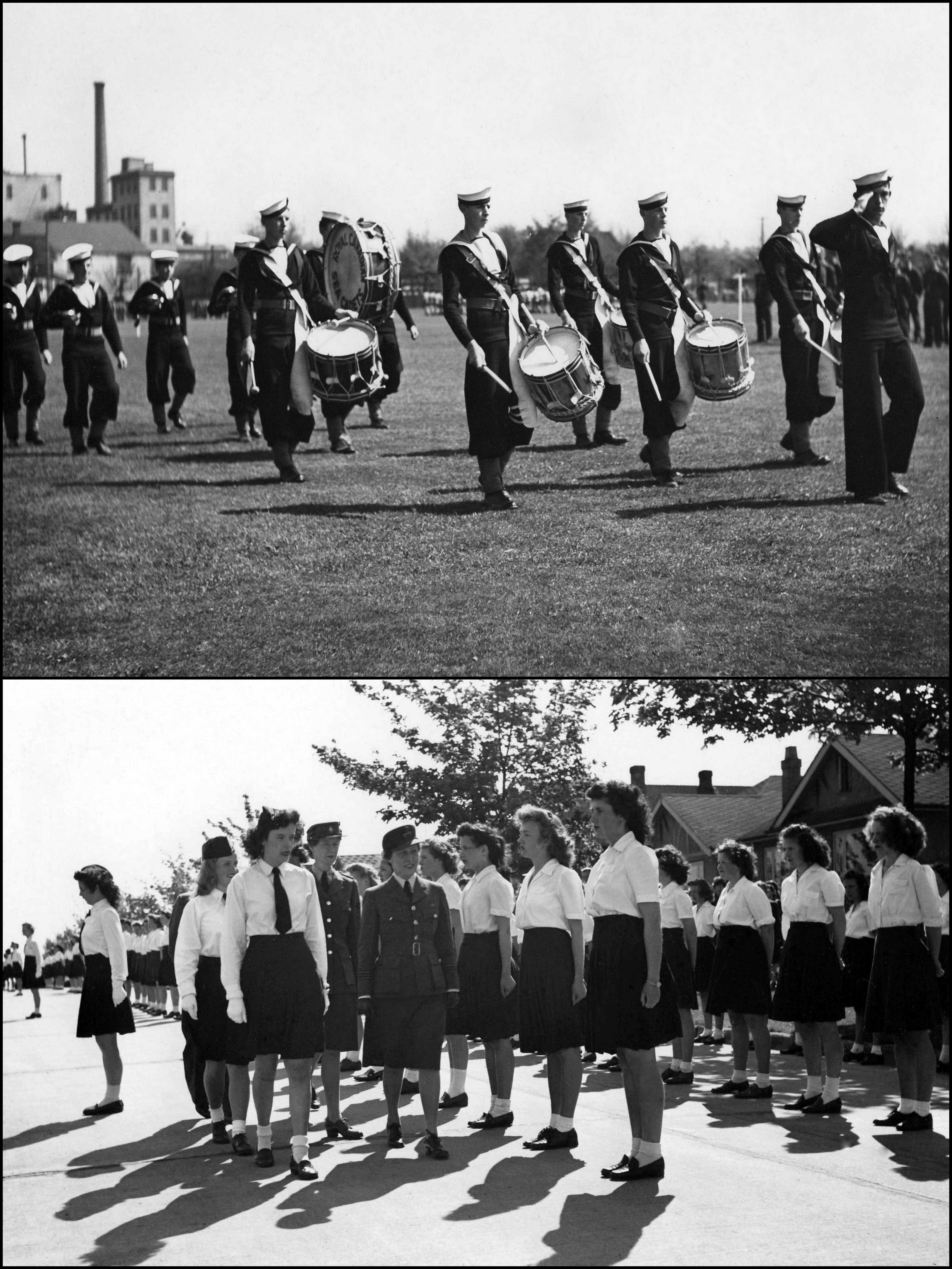
1944: (Top) Kitsilano High School Cadet Band. (Bottom) Senior officers inspect Kitsilano girl cadets.
It is a constant source of surprised comment by officers of the armed forces that the youths coming from the schools, or who have received their education in the last decade or so, are better educated, better disciplined, more responsive and teachable than any recruits they have had in their military experience. Military “crime” amongst these youths is negligible. The officers do not hesitate to give credit for these facts to the modern school.
Excerpt: REPORT OF H. B. KING, PH.D., CHIEF INSPECTOR OF SCHOOLS (1941-1942)
c) War work in the schools
Since the opening of hostilities in the Pacific area, Air-raid Precaution programmes have become essential. Inspector Thomas has been the school representative on the central committee, A.R.P., for the City of Vancouver.
At present, district A.R.P. posts are established in twenty-seven of the city schools and divisional posts in five others… Basic training for A.R.P was given to almost 900 teachers and 9,340 students… Training in first aid was given to over 500 teachers and almost 8000 pupils… High school cadets were employed as runners for the auxiliary fire services… All our schools have been provided with elementary fire-fighting equipment in case of incendiary bomb: sand-bags, water pails, rakes and shovels. Our city school buildings have been surveyed for use as emergency shelter, emergency feeding stations, and emergency hospitals.
Excerpt: Report of H.N. MacCorkindale, B.A., Superintendent of Schools, City of Vancouver (1941-42)
The teachers and pupils of our schools continue to show an increasing enthusiasm for work aimed at helping the armed forces of the United Nations and their families on the home front Following is a summary (approximate) of war-work in our schools from September, 1940, to December 31st, 1942:
- a) Salvage—rubber, 30,000 lb; paper, 350,000 lb., metal, 150,000 lb., toys, 25,000; buttons, 3000 dozen; bottles, 12,000 dozen; tinfoil, 12,000 lb., Bundles for Britain, 6000 articles; books and magazines for soldiers, 12,000.
- b) Made by Pupils—Handkerchiefs (khaki) 25,730; handkerchiefs (gauze), 7,222; wash-clothes, 13,3656; afghans, quilts, and rugs, 1095; sweaters, 1,981; socks, 1311 pairs; scarves 1521, children’s garments, 3,788; miscellaneous garments, 6451; ration cards completed for Ration Board, 167,200.
Excerpt: Report of H.N. MacCorkindale, B.A., Superintendent of Schools, City of Vancouver (1942-43)
1940: Laura Secord Elementary – scrap metal drive.
d) HEADLINES: King Edward High School Annual: 1941-42
‘War Comes to King Ed’
Cadet training at King Ed was swept into high gear. Strenuous drills held in any kind of weather, in any temperature, and at any time during the week, proved to make King Ed cadets highly proficient at the inspection May 11th.
Air cadet training was introduced just this year and the three senior grades at King Ed composed the Air Cadet Corps. The purpose of the Air Cadets of Canada is “to provide Canadian boys and young men with training and instruction similar to the elementary training of the Royal Air Force.”
Over fifty boys had special training in the officers’ training corps (O.T.C.), and were thoroughly trained to be cadet officers. Squadron Commander of No. 9 Squadron was Ed McGowan, and Squadron Commander of No. 10 Squadron was Leighton Brown.
Pupils of Grade 9 and 10 formed the militia or army cadets. From the ranks of the Militia Training Corp (O.T.S.) the school’s cadet leader was Jack Neil. Militia Cadets made a particularly fine showing at the inspection and were generously praised by the Inspecting Officer Major Critchley.
1940: Cadet training program: students on parade in front of King Edward High School.
‘Girls train for Any Emergency’
King Edward High School girls are not content to confine their war effort to knitting woolens for soldiers. They are training themselves to cope with any possible emergency. They are accomplishing as much as, and certainly working as hard as, the boys.
When the Boys’ Cadet Corps are drilling, girls immediately spread throughout the school to various groups where intensive war training is carried out.
When the Boys’ Cadet Corps are drilling, the girls immediately spread throughout the school to various groups where intensive war training is carried out.
An air raid precaution group studies poisonous gases—how to treat gas poisoning and how to apply gas masks.
Another group specializes in Signalling and the art of sending messages by morse-signalling to the far end of school corridors.
Nor are only the boys being drilled in Cadet work. Early in the term, six flights of girl cadets were formed and paraded smartly before students and parents May 11th during inspection by Air Force Officers.
Besides the ordinary First-Aid group, in which many students have been awarded First Aid certificates, are three other highly trained groups, all having Senior First Aid certificates, and all being matric students. These groups are prepared to take complete charge of Air Raid posts in the event of an air raid.
‘War Effort – If Bombs Should Fall’
WhooOOOoooOOOoo!! An air raid. Enemy bombers are approaching Vancouver. School air-raid signals are sounded and immediately 1200 students calmly but briskly walk from their classrooms to their homerooms and hand their teachers attendance slips. Within five minutes the school is cleared. Those students who live within 20 minutes’ walking distance of their home are already on their way home. The balance of the students are stationed in various parts of the school—protected on all sides by many feet of concrete
Bombs are exploding!!—one hits the school! Three injured students are immediately picked up by one of the ten stretcher squads and are carried to a relatively safe First Aid post. They are immediately treated by highly trained students. Others are being given hot drinks as a treatment for shock.
A fire bomb has been reported by a fire watcher. A fire-fighting crew rushes up—rolling a portable rack with all the necessary fire-fighting equipment on it. In three minutes the fire is out.
Both student and teacher have worked together for such preparation as outlined above—preparation which is necessary in times like these. Students and teachers have contributed over $132.00 for the A.R.P. equipment to supplement that given by the School Board. Bandages, splints, stretchers, first aid equipment of every description has been built and prepared by students
King Edward High School is taking no chances. The school is prepared.
 1940: Victory Garden: Sir William Dawson School
1940: Victory Garden: Sir William Dawson School
e) Victory in Europe; Victory in Japan
The war in Europe ended on May 7, 1945, when Germany’s General Alfred Jodl signed unconditional surrender documents for all German forces. Germany’s leader, Adolf Hitler, was dead, a suicide; his country under occupation by foreign armies. Fourteen weeks later, on August 14, Japan surrendered unconditionally, after atomic bombs dropped by U.S. aircraft had devastated the cities of Hiroshima (August 06) and Nagasaki (August 09).
The world wide toll in dead and wounded was enormous. By one estimate, 15 million combatants died and 25 million were wounded. Civilian deaths exceeded 45 million. Many other estimates are higher.
More than one million Canadians served in the armed forces. Of these, more than 44 thousand were killed and 55,000 were wounded. But, unlike many other countries, Canada was never a battleground. Its cities, industries, and farmlands escaped unscathed.
Date: May 08, 1945 Vancouverites celebrate V.E. Day (Victory in Europe) Photo credits: Vancouver City Archives
The Post-War Period: 1945-1950
- Introduction
Hopes for a lasting peace following World War Two faded as tensions rose over provocative actions taken by the Soviet Union to assert its control over the countries and territories it occupied in Eastern Europe. The establishment of a communist regime in China in 1949 heightened fears of renewed conflict in the Far East. Hanging over these events was the spectre of global atomic warfare. The American monopoly over atomic weapons ended in 1949 with the Soviet Union’s successful testing of an atomic bomb.
Canada’s economy had grown impressively during the Second World War due to large scale production of war materials and equipment such as weapons, munitions, trucks, ships, and aircraft. After the war, the system of production was retooled to meet the growing demand for housing, automobiles, home furnishings and appliances, and other domestic goods.
Government added to the sense of optimism and security felt by Canadians by adopting social welfare policies such as health insurance, old age pensions, and baby bonuses.
- The Vancouver School District
a) The Beginning of the ‘Baby Boom’.
Vancouver’s population had grown slowly during the 1930s. But then, due to growing job opportunities in war industries, and later, the arrival of immigrants from Great Britain and Europe, it expanded rapidly – from 275,353 in 1941 to 344,833 in 1951. Another reason was that the fertility rate in Canada (the number of children per woman) rose from 2.6 in the mid 1930s to 3.5 at the beginning of the 1950s. The resulting, rapid increase in the number of newborns in Vancouver, and North America generally, is popularly known as the ‘baby boom’. Within a few short years the effects of the baby boom were being seen in rapidly rising school enrollments (see Chapter Five. )
Construction of 1,000 houses by Wartime Housing (predecessor of CMHC), a Crown Corporation, began in 1944-45 on already serviced lots in the area bounded by Main, Fraser, Broadway, and Marine Drive…. Systematic development of two subdivisions, expressly built for veterans, followed, with houses in Renfrew Heights ready for occupation in 1948 and in Fraserview two years later. These developments caught the Board off-guard. It had predicted in 1945 little growth in the south and southeast sections of the City and expected the existing schools in these areas to absorb most population growth for some time to come.
Excerpt: Vancouver Schools – Establishing Their Heritage Value
b) Limited Standardized Planning
In preparation for a long-term building programme, the Board early in 1944 appointed Mr. E.D. King as their school architect. Mr. King and his department have made an excellent contribution to the long-term building plan.
It should be noted that that no attempt has been made to advocate a standardized plan for any type of school. This scheme has been tried in other countries but was found impractical because sites are not uniform as to slope, aspects, levels, positions, and sewer services. Any one of the above features may alter a plan entirely.
However, the Board and its officials have, through the principals’ and teachers’ building committees, have endeavored to standardize the equipment and fittings of certain kinds of rooms for certain types of schools and then leave to the architect the task of incorporating these into the larger unit required.
Excerpt: REPORT OF H.N. MacCorkindale, B.A., SUPERINTENDENT OF SCHOOLS (1945-46)
(Note: the different types of spaces in schools included gymnasium-auditoriums, lunch rooms/cafeterias, Industrial Arts shops, Home Economic laboratories, standard and specialized classrooms, medical/first aid rooms.)
c)Medical, Dental and Food Services
Vancouver used schools to deliver dental and medical services beginning in the twentieth century. These services, severely cut back during the Depression, were revived after the war. Purpose-built medical rooms were included in all new schools and inserted into older ones. Additional dental clinics were built. Lunchrooms were also added to many schools in the post-war period. Hot lunch programs, organized by parents are mentioned in numerous school histories in the context of the Depression and malnourished students. By the early 1940s, the Board was under pressure to provide facilities for preparation of and consumption of a hot lunch. Whether the pressure for hot lunches stemmed from nutritional concerns or increased numbers of families where parents were not at home at the noon hour is not articulated in the Board’s Annual Reports, but it is clear that Parent –Teacher Associations took on the provision of this service in many of the Board’s schools in the 1940s and that lunchrooms, with kitchens, were built to facilitate this.
Excerpt: Vancouver Schools – Establishing Their Heritage Value
1953: Visiting doctor monitors a student’s heart rate. Bayview Elementary School.
1958: Dental clinic at Sir Wilfred Laurier Elementary School.
1952: PTA (Parent Teacher Association) parents serve breakfast and hot chocolate to pupils at J. W. Sexsmith Elementary (bottom photo) and Sir William Van Horne Elementary (top two photos.)
d) Kindergartens
One of the most significant developments was the establishment of Vancouver’s first kindergartens, at Henry Hudson and Dawson Schools in 1944… By this time, the educational importance of kindergarten had gained relatively wide acceptance. More kindergartens were opened following the war, and in the 1950s kindergarten rooms were included in new schools and added to modernized ones.
Excerpt: Vancouver Schools—Establishing their Heritage Value
1964: Kindergarten pupils at Walter Moberly Elementary School.
MILESTONES IN PUBLIC EDUCATION (excerpts from A Short History of BC Education, University of Victoria)
- 1938 New standardized report cards are introduced during the 1938-39 school year for provincial elementary schools, along with explanatory letters for parents… Revised report cards for junior and senior high schools are introduced the following year.
- 1943 Bible readings are authorized by the Council of Public Instruction. In 1944, the Public School Act is duly amended to read: “All public schools… shall be opened by the reading, without explanation or comment, of a passage of scripture…to be followed by the recitation of the Lord’s Prayer.”
- 1944 The first provincially-funded Kindergarten classes are opened, on an experimental basis, in Vancouver and Victoria, when the Department of Education agrees to provide a grant towards the salary of kindergarten teachers.
- 1947 Membership in the British Columbia Teachers’ Federation is compulsory for all public school teachers, effective 1 April 1947.
- 1949 First steps, since the nineteenth century, towards integrating and accommodating First Nations students in the provincial public school system. An amendment to the Public School Act enables local Boards of School Trustees and the federal Department of Indian Affairs to enter into agreements for sharing the costs of schooling for aboriginal children.
HIGH SCHOOL ‘Snapshots’
Britannia High School (1945)
World War Two Role of Honour
John Oliver High School (1950)
Two students and their teacher celebrate their winning the George S. Mathieson Memorial Trophy for School Choirs.
King Edward High School (1940)
The entire cast of a musical production takes the stage.
Kitsilano (1945)
The cast and crew of an operetta pose for a photograph.
Lord Byng (1933)
Rugby Champions: Winners of the New Zealand Shield.
Magee (1950)
Rodney Garside, Jack Downs, Joan Gell, Lyrics & music by Mr. King, script by Mr. Donaldson, teachers. The setting of the show is the Canadian Rockies where four university students become involved in international intrigue. (Photo credit: Vancouver Sun)
Point Grey (1931)
An all-boy school band poses on the front steps of the school.
Templeton (1941)
A group of ‘young ladies’ poses for ‘Fashion of the Day’
Van Tech (1950)
Two students have some fun in their cooking class.


